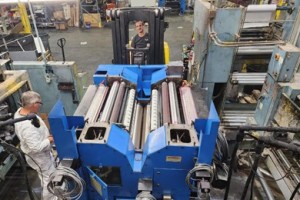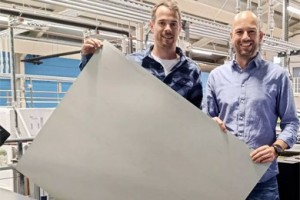
Not always the most favoured option, UV is popular in the USA and can be the only option, writes Peter Coleman
Half a dozen years after the first ‘new generation’ newspaper systems went into operation, UV is now established as process for semicommercial production on coated stocks.
US-headquartered Prime UV, the biggest vendor of single-width systems, claims more than 100 installations around the world and the support of pressmaker manroland for the inert UV variant – which uses nitrogen to speed curing – has helped draw the attention of major users around the world.
manroland-equipped sites at Herold in Vienna, ‘Le Monde’ in Paris, and most recently at Canadian contract printer Transcontinental Printing in Montreal have seen the big dollars of high-speed newspaper presses committed to UV. There, a triplewide Colorman XXL press has an Eltex inert UV system, the on a wide-format press.
Like Herold – which has been running since 2007 – the Montreal installation is based on eight-couple towers with a common impression cylinder, for which UV is the only practicable option, although Transcontinental teamed conventional heatset with the blanket-to-blanket 6x2 towers of its San Francisco Colorman presses in another first.
Meanwhile, Prime – which has the ‘runs on the board’ for single-width UV – recently equipped a Goss Uniliner with a 1680 mm web width. The company’s Erich Midlik believes air-cooled UV is the best option for newspaper production at 20,000-90,000 cph.
The ‘cold heat’ of inert UV has found its way to newspapers from the industrial-coatings market, where it had obvious advantages when printing film and other synthetic substrates. Supporters also claim the use of a chamber in which oxygen in air is displaced by nitrogen leads to reduced power consumption, estimated at up to 80 per cent less.
But if you’re printing on paper, the trade-off is between lower power use and higher installation costs, and failing a larger installed base, the jury’s still out. What is certain is that UV offers opportunities conventional heatset does not: The Herold installation for example, in inner-city Vienna, was to an existing satellite-style Colorman press.
Not only could they fit UV and an extra tower into the limited space available; UV lamps after each common impression cylinder – installed in a small ‘spacer’ unit – suited the satellite configuration in a manner impossible with heatset. In a new press installation, satellite aficionados still argue the relative merits of the configuration (mostly to do with registration) over the flexibility and ease-of-use of four-high (blanket-to-blanket) towers.
But this existing site was an acute example of UV’s retrofit advantage over heatset: Usually the argument is all about not being able to fit ovens into an existing pressroom without major building works... or at all. UV’s supporters claim that the curing process is really the only way ahead for printing on coated and other glossy paper stocks. “I am sure the future is not heatset,” says Jerome Godin of ink maker Arets Graphics.
And Midlik cites the example of US newspaper the ‘Colorado Mountain News’, which dumped the heatset oven it had bought with a secondhand three-tower DGM press, in favour of UV lamps. Their argument has a lot to do with environmental considerations – Midlik asserts ‘clean air’ and EPA legislation make UV curing the only option in some US states – but also with the value equation:
“UV offers lot of opportunity for minimal capital outlays,” he says. It’s for that reason that smaller single-width sites are seizing on UV to differentiate themselves in a crowded contract printing market. Newspaper user applications vary from companies bringing supplement and cover production inhouse, to a Saudi publisher with a need to keep their readers’ white clothing free of ink. Among the most recent installations are a Mexican marketing printer who has put in a UV-equipped Tensor T-400BE with a clever ribbon folder (see page 16) and a regional newspaper publisher in East Gippsland, Australia, the country’s first.
UV creates a high quality, upmarket product for which higher margins are possible, without the high capital cost – and regulatory requirements – of conventional heatset.
One, two or three-lamp curing units (according to press speed) are typically installed after the last print unit in a tower to cure both sides of the web, although they can be split as in a satellite configuration. There are no catalytic converters of afterburners, chill rolls or silicone applicators.
Midlik compares an estimated US$1.5 million to equip a high-speed single-width newspaper press with a conventional dryer to less than US$200,000 for UV. He specifies two lamps either side of the web for press speeds from 35,000-70,000 cph, with three lamps for 70,000-90,000 cph. The systems ‘warm up’ in less than a minute and use shutters to provide an instant shut-off when the press stops, with the system idling on low power. When the press is restarted, the shutters reopen and the system resumes production power, adjusting to the press speed.
Maintenance includes cleaning and inspecting lamps and reflectors, with lamps (costing US$250-400) having an estimated life of 2500-5000 hours, and reflector linings between 6000-10,000 hours. Midlik says the choice of consumables is fundamental, with suppliers of inks, plates, rollers, blankets and press chemistry playing a crucial role.
Choice will often depend on planned use – whether a tower will run only UV or a mix of UV and conventional coldset – with products available to meet both situations. The concerns over health and safety issues which effectively blocked UV in newspaper sites 40 or more years ago, have largely disappeared.
Use of gloves in handling UV inks is however recommended as they can cause skin irritation. Users weigh lower capital and energy costs against ink prices which are typically two-and-a-half to three times as expensive as heatset, but with their ‘higher strength’, consumption is usually less.
Godin says the issue is to teach printers the different characteristics of printing on coated stocks, notably using less water and less inks. And with thoughts increasingly turning to the ‘ozone hole’, there’s the warm feeling of using an ‘environmentally friendly’ product: UV is solvent-free chemistry, with no VOCs and no carbon dioxide, while a use of a kilogramme of heatset ink is claimed to lead to the creation of a kilogramme of CO2.
Bairnsdale's story
Australia’s first Prime UV system on a single-width newspaper press – at the ‘Bairnsdale Advertiser’ in south east Victoria – is attracting industry attention.But plans to exploit the unit’s potential are being frustrated by the local planning process, managing director Bob Yeates says. “We had hoped to relocate the printing plant to a site on the other side of town, but are still waiting on approval,” he says.
The planning issue has further complicated what had been intended as a relaxed approach to the pioneering process: When the Prime equipment was first installed at the beginning of last year, operation was delayed because of inadequate power supplies to the present building.
With the UV now up and running, the focus is on fine-tuning to optimise quality, but installation of extra Enkel splicers is having to wait until the move to the larger building.
Yeates says production of two quarterfold tourist publications for the region are being switched to UV, together with a variety of supplements for the stable of newspapers which includes the biweekly ‘Bairnsdale Advertiser’, and weekly ‘Snowy River Mail’, ‘Lakes Post’ and ‘East Gippsland News’.
The family-owned East Gippsland Newspapers – of which Yeates is the fourth generation – also publishes two bimonthlies for anglers and the visitors’ guides of which more than 100,000 copies are distributed a year.
“We’re very anxious to get everything right before we offer UV to commercial customers,” he says. “Factors such as the different inks used for UV mean that the prepress has to be optimised to get the best results.
“So far we haven’t really pushed it with customers, although people have been pleased with what we’ve done so far.”
Newsprint and a range of coated stocks mostly in the 80-90 gsm range have been used so far. The newspaper has a four-high tower dressed for hybrid UV production, as part of its four-tower Goss Community line.
The specification includes hybrid Brissett rollers, Vulcan Mytho hybrid blankets (from DS Chemport), and Flint Arrowlith UV ink. Standard DS Chemport chemistry is used, along with some special washes.
Production manager David Zagami says the intention had been to follow the example of similar US sites – notably in Los Angeles, San Francisco, New Orleans and Salt Lake City – visited 18 months ago.
“Back then most of these were in trial stages, and for competitive reasons, there wasn’t a lot of information being shared among them,” he says. “We’ve been pretty fortunate to learn from their mistakes and get it pretty right from the start.”
Views differed among the US sites about the use of different plates, baking and screening. In Bairnsdale, where violet Fuji plates are imaged on an ECRM platesetter, they have carried on as normal: No baking or FM screening yet, at least.
And Zagami’s prepress background has helped with tweaking profiles to meet the needs of dot gain which can rise to 30 per cent on some colours (notably yellow).
Wash-ups are also critical, as the tower – located immediately in front of the Goss SSC folder former – is being used for both UV and coldset inks (the latter from DIC). “Typically it will take us a couple of hours to wash up the tower,” Zagami says. “You’ve got to be very thorough.”
• Zagami will speak at the SWUG conference in Tamworth this month.
(From GXpress Magazine, March 2010)















Comments